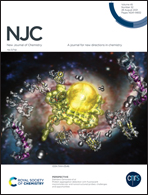A {BW12O40} hybrid decorated by Ag+ for use as a supercapacitor electrode material and photocatalyst†
Abstract
[BW12O40]5− anion has high surface charge density and strong coordination ability, which makes it easier to form a multifunctional composite with metal ions. Here, an inorganic–organic hybrid based on [BW12O40]5− was synthesized by a hydrothermal method, denoted as [{Ag(phen)2}4{Ag(phen)}2(H2BW12O40)2] (1) (phen = 1,10-phenanthroline). Interestingly, this compound can form one-dimensional, two-dimensional, and three-dimensional structures through hydrogen bonding and supramolecular action. Using the synthesized compound as the active electrode material in a three-electrode system, this compound exhibits redox peaks, indicating that the material can be used as a pseudocapacitor. At the current density of 2.16 A g−1, the specific capacitance was as high as 1647 F g−1. Importantly, it has excellent cycling stability such that the capacitance retention rate was still above 98.91% after 5000 cycles, which can be due to the polyoxometalate-based inorganic–organic hybrid structure. Moreover, the charge storage kinetics shows that the compound combines surface capacitance charge and diffusion control charge, and the charge storage mechanism is mainly based on surface capacitance. Besides, we studied the photocatalytic activity of 1 by the degradation of two dyes, namely rhodamine B (RhB) and methyl blue (MB). The results show that the degradation rate of MB is 93.09% in 90 min, while the degradation rate of RhB is 91.71% in 150 min. Therefore, we believe that the synthetic compound is an ideal electrode material for supercapacitors and a promising photocatalyst.



 Please wait while we load your content...
Please wait while we load your content...